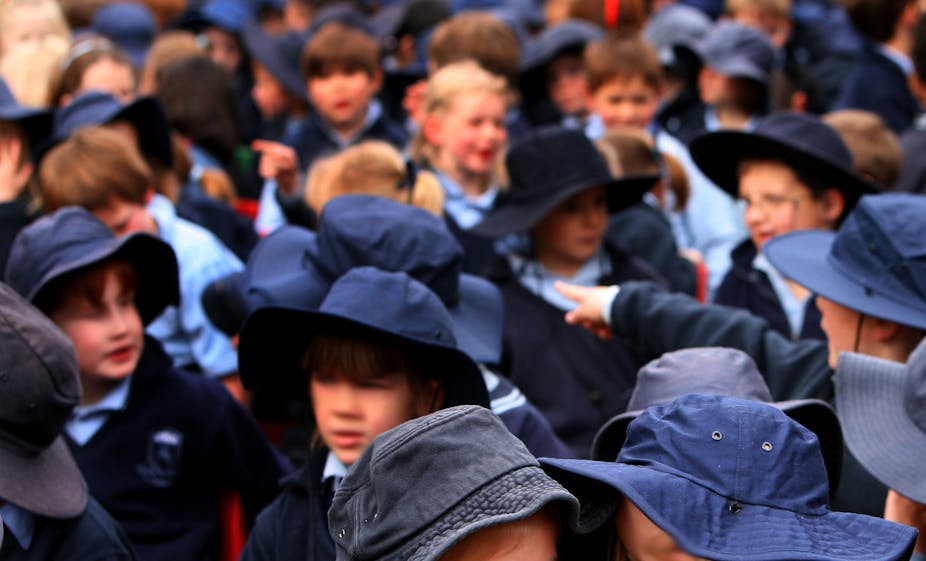The Gonski review of school funding promises to be a watershed in the history of Australian education. Much is at stake. There is a real chance to fundamentally change the way our divided school system works and for whom it works.
A short history of school funding
Tensions in how we fund our schools, how well they perform, and the impact they make on the lives of Australians have built up over time in successive waves.
The early post-war decades saw public schooling expand at an unprecedented rate, creating opportunities unknown before the war. The private sector contracted. It carried little of the weight of social and economic change applied to the public sector, which was poorly resourced and severely stretched.
But the funding framework constructed with much hope in 1972-73 to support public schools and restore non-government schooling was undermined from the start. Conflict resumed as increasing resources went to non-government schools to support choice and commonwealth efforts for public schools stalled and faltered. The viability of public schools was weakened, while at the same time greater and greater accountability was required to improve their performance or face market extinction.
Going nowhere
Today, as yesterday, the poorest fifth of all schools in Australia are almost all government schools.
Today, as decades ago, four-fifths of the poorest children attend government schools.
Over the same period, more and more educated and prosperous families have been subsidised to shift to private schooling. Public schools have had to defend themselves in this context on many fronts — against depletion of student numbers and student mix, against contractionary budgets of state governments, against hostility from sections of the media, and against a tenacious ideology that says resources do not matter (so spending on public schools, though not private schools is a waste).
An upside down mess
But at the same time expectations have risen.
Greater demands are being made on the largest and most exposed system, and are being enforced through annual national testing, performance agreements, and management contracts. Public schools have become a sector which is policed, while private schools have become a sector of preference.
Australian policy makers have created this division, which is uniquely Antipodean, a fact not lost on private school lobby groups who have warned Gonksi off international comparisons as incompatible with Australian “tradition”.
Our funding system is indeed upside down. For it diverts resources into choice and away from the schools that most need to work well.
The average child in a public school located in a high SES community is two years ahead of the average child in a school located in a poor area. The middle classes are thus well served by their local government school, but public policy in Australia since the mid-1960s has multiplied options for these classes when their social power and cultural capital already assured them of high standards in the public system.
The great diversion of effort from tackling disadvantage to multiplying choice has achieved nothing for the poor. It has created an over-resourced, corporatised and solipsistic private sector that sees nothing of what its unimpeded growth leaves behind.
The wrong debate
Much has been written for the Gonski review to paint a softer picture. Sermons are preached on the evil divisiveness of “us and them”, scandalous comparisons of income are denounced as “illegitimate” (not only invalid), and private schools parade their randomly-selected poor as proof of openness to all.
The theme has been the far-from-privileged nature of private schooling as a simply-better-performing version of public schooling. All schools, the argument runs, are close to the people, except for a few princely palaces whose antique exteriors obstruct the view.
How little debate there would be if this were truly the case! Alas the problem runs very much deeper. Much of the public funds spent on private schools flows not into the coffers of Kings or Haileybury, but into the mass of Catholic and less-than-notorious private establishments, opened in the past few decades or resuscitated from academic oblivion in the sixties.
These schools critically depend on public money because their fee income is too low. They need fees to filter their intakes and outperform government schools. But they could not survive in the marketplace on their own.
A drain on the system
Keeping these, the majority of non-government schools, on life-support comes at a very high price. It uses up the resources needed to eliminate under-achievement in the public system. It also uses up the cultural resources represented by educational level, know-how, values and aspirations that are needed to make the public system work consistently well, but are applied to segregation in a private system that adds little value of its own.
This is why real change cannot come from targeting the rich. But it is an even bigger mistake to imagine working-class and lower middle-class families are best served by splitting them up and dividing the scarce public dollar between them. That is not a recipe for either productivity or equity.
Public schools are community assets which only work well when financial and cultural resources are pooled in them. This is the only way to get value for money and justice into the bargain.
Will Gonski see it this way or will the review bow to tradition? The review committee must surely know that their answer will affect the future of Australia’s most disadvantaged families.

